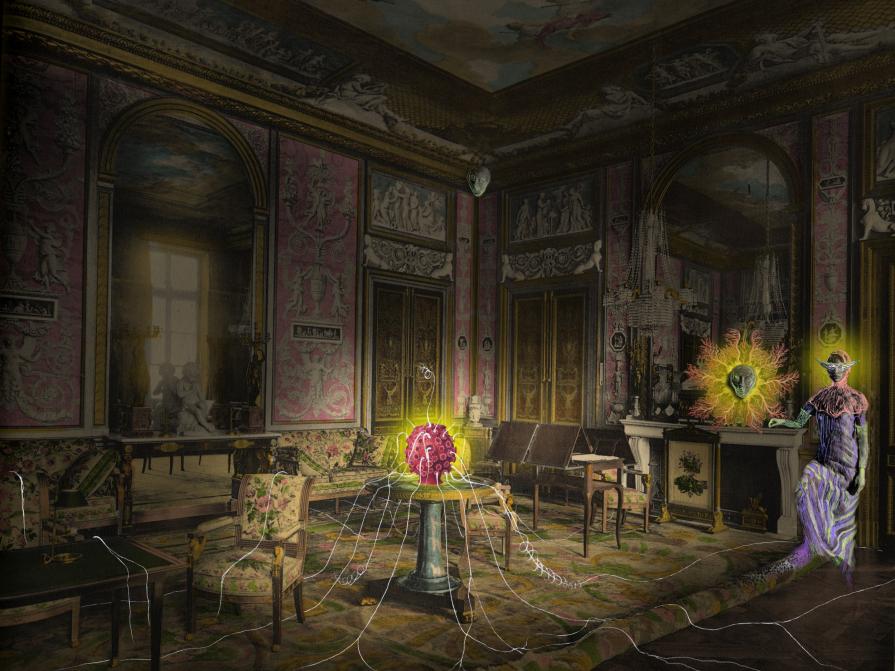
Donna Criminale
A patron saint of those who are thought to be low or marginal, the wrong kind of people, ‘the others’.
The sociologist Zygmunt Bauman has noted that in contemporary consumer society, we have begun to see the poor, those who cannot participate enough in consuming, as criminals.
Donna Criminale is a project documenting social questions around a banned artwork and dealing with new forms of censorship and social inequality in contemporary market-based society. – The work is an installation with variable dimensions, a hybrid conceptual-political project consisting of a toilet paper sculpture, photographic prints based on a digital collage, and a book.
The project interprets the contemporary market economy as a mystery religion, worshipped every day and everywhere on the globe, and striving to secure its position as the first global religion. It is successful, because instead of suffering and ethics, it speaks of winning and never-ending enjoyment. It has, at least in advertisements and hopes, made the luxurious surrealism come true. Women have to serve as the sacrificial animal and fetish of this flourishing social structure. After decenniums of development in gender equality, market society has attracted women to focus on seduction: to consume and to advertise it, but also to embody it.
As Bauman states, the hedonistic consumerism has a counter-effect, growing inequality. The ”low” workers in white gowns, from nurses to housemaids and cleaning ladies, have often been treated degradingly, as cheaper or more inhuman than toilet paper.
Contemporary consumerist society has also resulted in a new kind of censorship, founded on market-based values and neoliberal ideology. The project Donna Criminale is based on a real and personal case of an artist as a despised criminal who touched a taboo. In this true story behind the work, an artwork led to a trial and the artist was found to be a guilty criminal, who was prohibited to criticize a mass market phenomenon, although the production and consumption of the same market were bypassed as legal. If in advanced capitalism those in lower social positions are treated as criminals, the same can be true for an artist who comments on social phenomena. The book studies the blind spots in society around this art trial case, and gathers together different visual parts and artworks in the project.
The religious status of market capitalism, its position as a taboo outside criticism, was clearly seen in this art trial case in Finland. It was required that the holy trinity of advertisements, celebrities and porn can only be referred to if the brands and stars are masked and remain unknown. It was expected that when speaking about the market, we need blindfolds – a demand that makes a truthful view and critique impossible.
The banners of this project explore how to recognize a criminal woman – a famous Italian positivist criminologist, Cesare Lombroso, often cited as the father of criminology, wrote a book on the same theme over a hundred years ago. Lombroso tried to distinguish criminals on the basis of their appearance, and saw criminals as being born as such rather than made. If Lombroso understood that a born criminal has large ears, his Finnish successors saw that an artist dressed in white (the color of the standard toilet paper), must surely be a criminal.
This thought, presented by Lombroso, of certain inferior groups of humans, can be found at the root of the values of the Third Reich. It is not so long ago when those interpreted as being lower were gathered to be retrained, i.e. eliminated. A similar belief that certain people are ”objectively” higher, better, more worth of profit, is also alive in contemporary democratic society with its special kind of censorship.
_ _ _ _ _ _ _ _ _ _
- project can be exhibited as a smaller or bigger whole
- size of the installation, in its original place, was about 1000 m2, but the work can be cut to much smaller pieces, f.ex. the hanged goddess or photographic diasecs have been exhibited also alone
- series of aluminium mounted photographic prints (6), The Blind Spot Society, each 80x60cm
- banners (8), dealing with how to distinguish a criminal woman, each 200x150cm
- picture&essay-book "Donna Criminale: Capitalism as Religion, Market Criticism as Crime", BGBG, 128 pages, colors 4/4, 29x24 cm, languages English/Finnish. Artworks and graphic design by Ulla Karttunen. Texts by PhD, Ass. Professor Mojca Puncer; PhD, Professor Anita Seppä; PhD, Professor Yrjö Sepänmaa; and Ulla Karttunen.








































Commenti 12
Inserisci commento